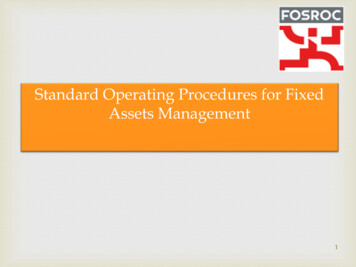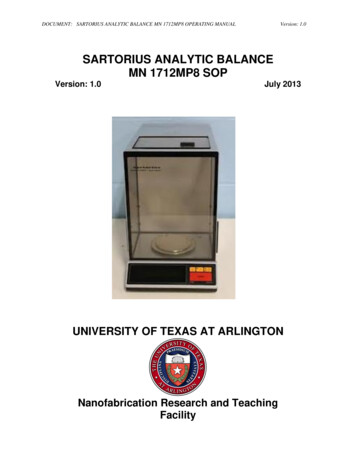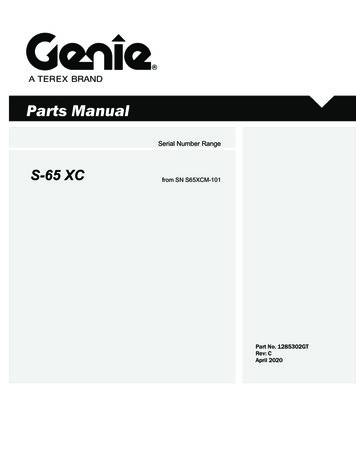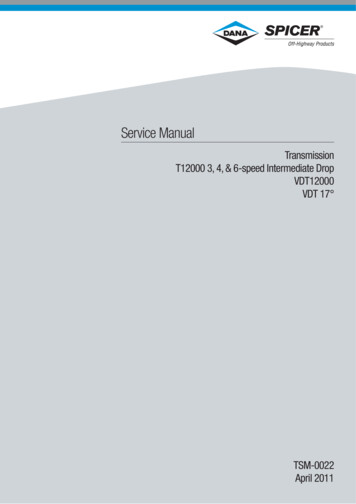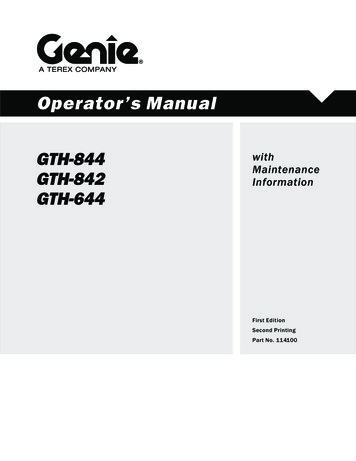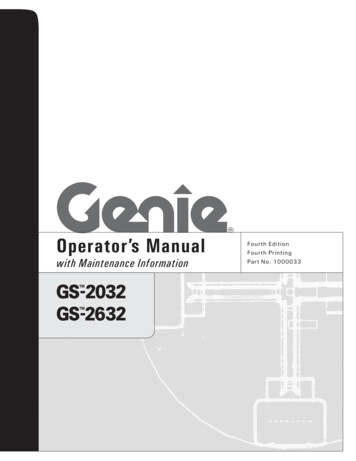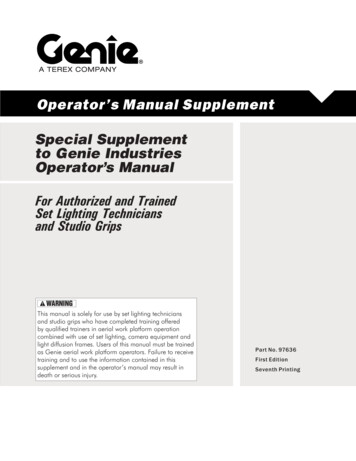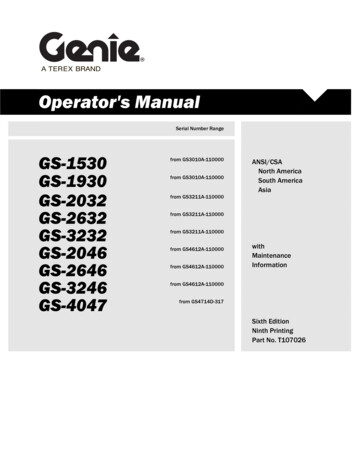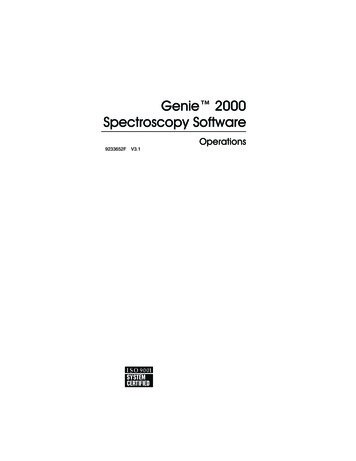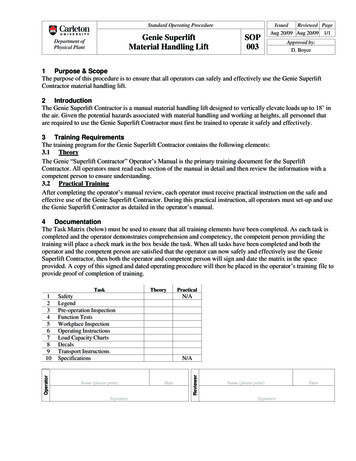
Transcription
Standard Operating ProcedureGenie SuperliftMaterial Handling LiftDepartment ofPhysical PlantIssuedSOP003Reviewed PageAug 20/09 Aug 20/09 1/1Approved by:D. Boyce1 Purpose & ScopeThe purpose of this procedure is to ensure that all operators can safely and effectively use the Genie SuperliftContractor material handling lift.2 IntroductionThe Genie Superlift Contractor is a manual material handling lift designed to vertically elevate loads up to 18’ inthe air. Given the potential hazards associated with material handling and working at heights, all personnel thatare required to use the Genie Superlift Contractor must first be trained to operate it safely and effectively.3 Training RequirementsThe training program for the Genie Superlift Contractor contains the following elements:3.1 TheoryThe Genie “Superlift Contractor” Operator’s Manual is the primary training document for the SuperliftContractor. All operators must read each section of the manual in detail and then review the information with acompetent person to ensure understanding.3.2 Practical TrainingAfter completing the operator’s manual review, each operator must receive practical instruction on the safe andeffective use of the Genie Superlift Contractor. During this practical instruction, all operators must set-up and usethe Genie Superlift Contractor as detailed in the operator’s manual.4 DocumentationThe Task Matrix (below) must be used to ensure that all training elements have been completed. As each task iscompleted and the operator demonstrates comprehension and competency, the competent person providing thetraining will place a check mark in the box beside the task. When all tasks have been completed and both theoperator and the competent person are satisfied that the operator can now safely and effectively use the GenieSuperlift Contractor, then both the operator and competent person will sign and date the matrix in the spaceprovided. A copy of this signed and dated operating procedure will then be placed in the operator’s training file toprovide proof of completion of training.OperatorTheorySafetyLegendPre-operation InspectionFunction TestsWorkplace InspectionOperating InstructionsLoad Capacity ChartsDecalsTransport InstructionsSpecificationsName (please 5678910Name (please print)SignatureDate
Operator’s ManualFirst EditionSeventh PrintingPart No. 33547
Operator's ManualFirst Edition Seventh PrintingImportantRead, understand and obey these safety rules andoperating instructions before operating this machine.Only trained and authorized personnel shall bepermitted to operate this machine. This manual shouldbe considered a permanent part of your machine andshould remain with the machine at all times. If you haveany questions, call Genie Industries.ContentsPageSafety . 1Legend . 6Pre-operation Inspection . 7Function Tests . 9Workplace Inspection . 13Operating Instructions . 14Load Capacity Charts . 16Decals . 18Transport Instructions . 22Specifications . 23Contact us:Internet: http://www.genielift.come-mail: techpub@genieind.comCopyright 1995 by Genie IndustriesFirst Edition: Seventh Printing, January 2004"Genie" and "Superlift Contractor" areregistered trademarks of Genie Industries inthe U.S.A. and many other countries.Printed on recycled paperPrinted in U.S.A.Genie Superlift ContractorPart No. 33547
First Edition Seventh PrintingOperator's ManualSafety RulesWarningFailure to obey the instructions andsafety rules in this manual mayresult in death or serious injury.Do Not Operate Unless:You learn and practice the principles of safemachine operation contained in this operator'smanual.1 Avoid hazardous situations.Know and understand the safety rules beforegoing on to the next section.2 Always perform a pre-operationinspection.3 Always perform the function tests prior touse.4 Inspect the workplace.5 Only use the machine as it was intended.You read, understand and obey themanufacturer's instructions and safety rules—safety and operator's manuals and machinedecals.You read, understand and obey employer'ssafety rules and worksite regulations.You read, understand and obey all applicablegovernmental regulations.You are properly trained to safely operate themachine.Part No. 33547Genie Superlift Contractor1
Operator's ManualFirst Edition Seventh PrintingSAFETY RULESFall HazardsDo not use as a personnel lifting platform or step.Do not stand on the load handling attachments.Do not raise the load unlessthe load handlingattachment is properlysecured to the machine.Do not use blocks to levelthe machine.Do not climb on the mast.Tip-over HazardsDo not raise the load unless the stabilizers (ifequipped) and legs have been fully lowered andlocked and the casters are in full contact with theground.Do not move the machinewith a raised load, exceptfor minor positioning.Do not operate the machine in strong or gustywinds. Increasing the load surface area willdecrease machine stability in windy conditions.Do not raise the load unlessthe leg retainer pins areproperly inserted throughthe leg and the base.Do not remove the legretainer pins while themachine is loaded and/orraised.Do not raise the load unless the machine is on afirm, level surface.Do not leave a load raised when windy conditionsmay occur unless the machine(s) are properly guywired.Do not exceed the rated load capacity. See LoadCapacity Charts section.Avoid debris and uneven surfaces while rolling amachine with the legs folded up.Prior to use, check the work area for drop-offs,holes, bumps, debris, unstable or slippery surfacesor other possible hazardous conditions.2Do not replace machine parts critical to stability orstructure with items of different weight orspecification.Do not cause a horizontal force or side load to themachine by raising or lowering a fixed oroverhanging load.Genie Superlift ContractorPart No. 33547
First Edition Seventh PrintingOperator's ManualSAFETY RULESDo not place ladders or scaffolding against any partof the machine.Electrocution HazardsThis machine is notelectrically insulated andwill not provide protectionfrom contact with orproximity to electricalcurrent.Do not use the machine on a moving or mobilesurface or vehicle.Collision HazardsCheck the work area foroverhead obstructionsor other possiblehazards.Do not tilt the machineback unless the area isclear of personnel andobstructions.Use common sense and planning when transportingthe machine on an incline or slope.Do not load for transport unless the machine andvehicle are on a level surface. Use proper liftingtechniques to load the machine.Keep away from themachine if it contactsenergized power lines. Personnel must not touch oroperate the machine until power lines are shut off.Maintain safe distances away from electrical powerlines and apparatus in accordance with applicablegovernmental regulations and the following chart.VoltageMinimum SafeApproach DistancePhase to PhaseFeet0 to 300V300V to 50KV50KV to 200KV200KV to 350KV350KV to 500KV500KV to 750KV750KV to 1000KVAvoid Contact103.1154.6206.1257.63510.74513.7MetersAllow for mast movement and electrical line swayor sag, and be aware of strong or gusty winds.Do not use the machine as a ground for welding.Lifting HazardsUse proper lifting techniques to load or tip themachine.Use proper lifting techniques when installing orremoving the load handling attachments.Part No. 33547Genie Superlift Contractor3
Operator's ManualFirst Edition Seventh PrintingSAFETY RULESCrushing HazardsDamaged Machine HazardsKeep hands and fingers away from folding legs andother potential pinch points.Do not use a damaged ormalfunctioning machine.Do not raise if the load is not properly centered onthe load handling attachment.Do not use a machine with aworn, frayed, kinked ordamaged cable.Do not raise unless the load is properly secured tothe load handling attachment.Do not use a machine with lessthan four wraps of cable on thewinch drum when the carriageis fully lowered.Do not stand under orallow personnel underthe machine when theload is raised.Conduct a thoroughpre-operation inspection prior toeach use.Do not lower the loadunless the area below isclear of personnel andobstructions.Be sure all decals are in place and legible.Do not stand under the load. The safety brakesystem (if equipped) will allow the load to drop 1 to3 feet / 30 to 91 cm before locking the columns.Maintain a firm grasp on the stabilizer when thelock plates are released. The stabilizer will drop.Maintain a firm grasp on the leg when the retainingpin is removed. The leg will drop.Maintain a firm grasp on the winch handles until thebrake is locked. The brake is locked when the loadwill not cause the winch handles to turn.Be sure the operator's manual is complete, legibleand in the storage container located on themachine.Maintain proper lubrication on the winch. See GenieSuperlift Contractor Parts and Service Manual fordetails. Do not allow oil or grease on brakingsurfaces.Do not use any type of lubrication on the columnsurfaces.Bodily Injury HazardDo not grasp the cable.Improper Use HazardNever leave a machine unattended with a load.Unauthorized personnel may attempt to operate themachine without proper instruction, creating anunsafe condition.4Genie Superlift ContractorPart No. 33547
First Edition Seventh PrintingOperator's ManualSAFETY RULESDecal LegendGenie product decals use symbols, color codingand signal words to identify the following:Safety alert symbol—used to alertpersonnel to potential personalinjury hazards. Obey all safetymessages that follow this symbolto avoid possible injury or death.Red—used to indicate thepresence of an imminentlyhazardous situation which, if notavoided, will result in death orserious injury.Orange—used to indicate thepresence of a potentiallyhazardous situation which, if notavoided, could result in death orserious injury.Yellow with safety alert symbol—used to indicate the presence of apotentially hazardous situationwhich, if not avoided, may causeminor or moderate injury.Yellow without safety alertsymbol—used to indicate thepresence of a potentiallyhazardous situation which, if notavoided, may result in propertydamage.Green—used to indicate operationor maintenance information.Part No. 33547Genie Superlift Contractor5
Operator's ManualFirst Edition Seventh 171615141Winch10 Boom19 Stabilizer caster2Lifting bracket11 Shackle20 Base3Cable12 Fork extension21 Stabilizer brace4Mast13 Pipe cradle5Carriage14 Leg swivel caster22 Base swivel/lock caster withbrake6Standard forks15 Leg23 Transport wheel7Load handling attachmentretaining pin16 Hold-down bar24 Mast brace17 Leg retaining pin8Adjustable forks18 Stabilizer (if equipped)25 Loading wheels/steerhandles9Snap pin6Genie Superlift ContractorPart No. 33547
First Edition Seventh PrintingOperator's ManualPre-operation InspectionFundamentalsThe pre-operation inspection is a visual inspectionperformed by the operator prior to each work shift.This inspection is designed to discover if anythingis apparently wrong with a machine before theoperator tests it.Do Not Operate Unless:You learn and practice the principles of safemachine operation contained in this operator'smanual.1 Avoid hazardous situations.2 Always perform a pre-operationinspection.Know and understand the pre-operationinspection before going on to the nextsection.3 Always perform function tests prior to use.Refer to the list on the next page and check eachof the items.If damage or any unauthorized variation fromfactory delivered condition is discovered, themachine must be tagged and removed fromservice.Repairs to the machine may only be made by aqualified service technician, according to themanufacturer's specifications. After repairs arecompleted, the operator must perform a preoperation inspection again before going on to thefunction tests.4 Inspect the workplace.5 Only use the machine as it was intended.Part No. 33547Genie Superlift Contractor7
Operator's ManualFirst Edition Seventh PrintingPRE-OPERATION INSPECTIONPre-operation Inspectiono Be sure that the operator’s manual is complete,legible and in the storage container located onthe machine.o Be sure that all decals are legible and in place.See Decals section.Check the following components or areas fordamage, improperly installed or missing parts andunauthorized modifications:o Winch and related componentsCheck the entire machine for:o Dents or damageo Corrosion or oxidationo Cracks in welds or structural componentso Be sure that all structural and other criticalcomponents are present and all associatedfasteners and pins are in place and properlytightened.o Be sure there is a minimum of 4 wraps of cablearound the winch drum when the carriage is fullylowered.o Base componentso Legso Stabilizers and latch plates (if equipped)o Mast columnso Carriage hold-down baro Cable anchoro Cable and pulleyso Wheels and casterso Load handling attachmentso Nuts, bolts and other fastenerso Cable (kinks, frays, abrasions)8Genie Superlift ContractorPart No. 33547
First Edition Seventh PrintingOperator's ManualFunction TestsFundamentalsThe function tests are designed to discover anymalfunctions before the machine is put into service.The operator must follow the step-by-stepinstructions to test all machine functions.Do Not Operate Unless:You learn and practice the principles of
training will place a check mark in the box beside the task. When all tasks have been completed and both the operator and the competent person are satisfied that the operator can now safely and effectively use the Genie Superlift Contractor, then both the operator and competent person will sign and date the matrix in the space provided. A copy of this signed and dated operating procedure will then be placed in the operator’s training File Size: 837KBPage Count: 27

